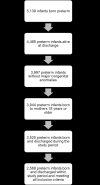Perinatal determinants of growth trajectories in children born preterm
- PMID: 33507964
- PMCID: PMC7842887
- DOI: 10.1371/journal.pone.0245387
Perinatal determinants of growth trajectories in children born preterm
Abstract
Background: A growing amount of evidence indicates in utero and early life growth has profound, long-term consequences for an individual's health throughout the life course; however, there is limited data in preterm infants, a vulnerable population at risk for growth abnormalities.
Objective: To address the gap in knowledge concerning early growth and its determinants in preterm infants.
Methods: A retrospective cohort study was performed using a population of preterm (< 37 weeks gestation) infants obtained from an electronic medical record database. Weight z-scores were acquired from discharge until roughly two years corrected age. Linear mixed effects modeling, with random slopes and intercepts, was employed to estimate growth trajectories.
Results: Thirteen variables, including maternal race, hypertension during pregnancy, preeclampsia, first trimester body mass index, multiple status, gestational age, birth weight, birth length, head circumference, year of birth, length of birth hospitalization stay, total parenteral nutrition, and dextrose treatment, were significantly associated with growth rates of preterm infants in univariate analyses. A small percentage (1.32% - 2.07%) of the variation in the growth of preterm infants can be explained in a joint model of these perinatal factors. In extremely preterm infants, additional variation in growth trajectories can be explained by conditions whose risk differs by degree of prematurity. Specifically, infants with periventricular leukomalacia or retinopathy of prematurity experienced decelerated rates of growth compared to infants without such conditions.
Conclusions: Factors found to influence growth over time in children born at term also affect growth of preterm infants. The strength of association and the magnitude of the effect varied by gestational age, revealing that significant heterogeneity in growth and its determinants exists within the preterm population.
Conflict of interest statement
The authors have declared that no competing interests exist.
References
-
- Dietz WH. Health consequences of obesity in youth: childhood predictors of adult disease. Pediatrics. 1998;101(3 Pt 2):518–25. . - PubMed
Publication types
MeSH terms
Grants and funding
LinkOut - more resources
Full Text Sources
Other Literature Sources
Medical
Miscellaneous


